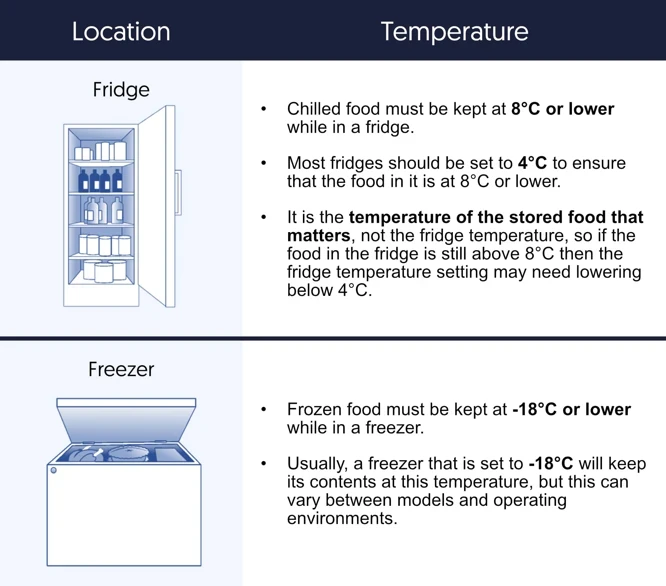Storing food at the correct temperature is an important part of food safety, and it helps to prevent the growth of harmful bacteria and ensure that food is safe to eat. There are also strict laws that dictate the minimum or maximum temperatures that food should be stored at.
For this reason, it is essential that anyone who works in a food business understands safe storage of food, and the ideal temperatures that the foods they work with should be stored at.
In this article, we will answer several frequently asked questions about safe food temperatures, and how food should be stored in a fridge and freezer.
If you want to understand the wider principles behind safe food handling, take a look at our full food safety guide.
![food temperature storage guide infographic food temperature storage guide infographic]()
Which temperature range is the danger zone for food storage?
Before looking at what the main food storage temperatures are, it is important to understand where they come from.
Most harmful bacteria grow at temperatures above 8°C and below 63°C, which is known as the ‘danger zone’ for food storage. To ensure its safety, certain high-risk foods must be stored at a temperature below the danger zone, and cooked to a temperature above it, by law.
What is the maximum storage temperature for chilled food?
All chilled foods, especially high-risk foods, must be kept at 8°C or below while in storage. This is because the growth of bacteria is slowed at this temperature, ensuring that it is safe to eat for a longer period of time.
What temperature should a fridge be set at?
The temperature of a fridge can vary throughout it, with the coldest part of the fridge being next to the cooling coil or shelf at the bottom. The best temperature for a fridge is 4°C at its coldest point, as this will ensure that all food stored in it has a temperature of below 8°C.
Be aware that it is the temperature of the stored food that matters, not the fridge temperature, so if the stored food is still above 8°C then the fridge temperature setting may need lowering below 4°C.
For more information on storing food in a fridge, click here to view our article on good refrigerated food storage practice.
What temperature should a freezer be set at?
Frozen food should be stored at -18°C or colder, as this is the temperature at which the majority of bacterial growth stops. Just like fridges, this is the temperature that the food itself should be, so a freezer may need to be set to a cooler temperature as a result.
However, care should be taken when setting freezer temperatures because setting it too low can needlessly increase energy usage, and lead to freezer burn.
What is freezer burn?
Certain foods will lose moisture when exposed to cold air, including that found in a freezer. While this does not negatively affect the safety of food, it can affect its taste and texture, and should be avoided as a result.
What temperature must chilled food be delivered and stored at?
Chilled food must always be stored below 8°C, regardless of where it is being kept. This means that any chilled food being shipped, stored or delivered must be packaged in such a way as to ensure that its temperature does not exceed 8°C before it reaches its destination.
At Commodious, we offer a range of food safety training courses that, among other things, covers safe food storage and cooking temperatures. They also lead to an Institute of Hospitality endorsed certificate that can be used to prove your knowledge.
Level 2 Food Hygiene and Safety for Catering
Level 2 Food Hygiene and Safety for Manufacturing
Level 2 Food Hygiene and Safety for Retail
For more information on our other food safety courses, click here.









